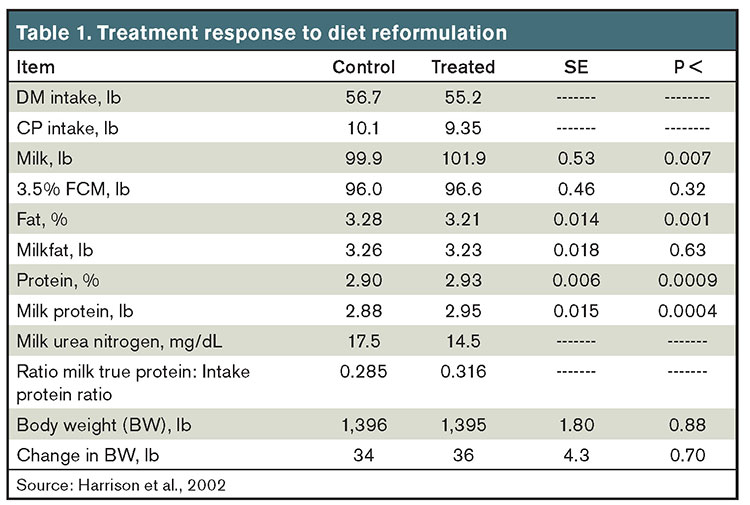Feed represents the largest import of nutrients to most livestock and poultry farms, followed by commercial fertilizer. Feed management opportunities exist to reduce imports of nutrients, particularly nitrogen and phosphorus, to most livestock operations. The technologies and approaches to achieve these reductions vary in their degree of economic feasibility and environmental impact.
In 2006, a feed management education project was implemented for beef, dairy, poultry, and swine. The project was national in scope and designed to encourage adoption of the Natural Resources Conservation Service (NRCS) Feed Management Conservation Practice Standard 592 and feed management practices that can have a positive impact on soil and water. Detailed information can be found at bit.ly/JNM-WSUpublications.
Reduce nutrient imports
Feed management is one of six core elements in a Comprehensive Nutrient Management Plan (CNMP).
The initial activity associated with the development of a feed management plan is to conduct an on-farm checklist designed to identify those practices that will most likely reduce imports of nutrients and/or improve profitability. The most common practices that can reduce imported feed nutrients on the farm include:
• Diet formulation to meet the requirements of the animal
• Feeding animals in groups
• Regularly analyzing ingredients or diets for nutrient content
• Formulating livestock diets for protein fractions
• Utilizing growth promotants and ionophores
• Using enzymes
Once it has been determined that a feed management plan is a good decision for a farm, a feed management plan checklist is then utilized to collect information that will be used to complete the plan. Categories of items in the feed management plan checklist are:
• Targeting nutrient requirements
• Ration balancing
• Ration management practices
• Production aids/enhancers
• Monitoring tools
The feed management plan template is designed to outline and document the practices that will assist with minimizing the import of feed nutrients to the farm. In addition, it is designed to create a “live” document to use in strategic and tactical planning. Special attention is given to sampling frequency, analysis of specific nutrients, specific recommendations on practices to adopt, how the feed management plan will change the nutrient composition of manure, and specific review dates.
An intermediary step in the implementation of a Feed Management Plan that will be considered by some livestock and poultry operations is the economic evaluation of the choice to make ration changes or transport manure a farther distance. What follows are some dairy specific nutrient reduction opportunities.
Feed for reduced crude protein
The transition from feeding the dairy cow for its crude protein requirement has clearly progressed today to a more sophisticated approach of formulating for the estimated requirement of amino acids. While this transition has been occurring, there has been a simultaneous progression for a greater awareness of the interrelationship of diet formulation and feed management on whole farm nutrient oversight.
Amino acid formulation
Amino acid formulation for dairy cattle has been a common practice since the availability of the Cornell Net Carbohydrate and Protein System model and the Cornell-Penn-Miner model. Both models have been used successfully to strategically formulate diets to evaluate the merits of sources of ruminally undegraded protein (RUP), ruminally protected amino acids, and free lysine-HCL. Other researchers have had positive experiences with use of the model to formulate diets to reduce the crude protein (CP) level in the diet while maintaining milk production.


Other studies I conducted continue to provide evidence that formulating diets for available amino acids can provide the opportunity to lower CP levels in the diet and reduce the on-farm import of nitrogen. A field study was done with a high-producing herd to compare their general herd diet formulated at approximately 18% CP to a diet that was reformulated at around 17% CP. Results showed that milk production could be maintained while reducing nitrogen import to the farm (Tables 1 and 2). In addition, the diet reformulation resulted in an improvement in income over feed cost (IOFC), as shown in Table 3.

The phosphorus feeding myth
A major reason for overfeeding P to dairy cows is concerns related to reproductive efficiency. Past research has related P deficiency to health and reproductive problems, including failure to conceive and reduced calving rates. Extensive reviews on the topic have been published.
In retrospect, it appears that low P intake was linked to impaired reproductive performance in cattle through a series of confounded and misinterpreted experimental data reported in the late 1920s through the 1950s.
A summary of 13 trials with lactating dairy cows (392 to 393 cows) and heifers (116 to 123 heifers) showed no effect of dietary P on reproductive performance. Levels of P in the cow diets varied from 0.32% to 0.40% (low-P groups) and from 0.39% to 0.61% (high-P groups) of dry matter (DM). Heifers were fed 0.14% to 0.22% and 0.32% to 0.36% dietary P, respectively.
Days to first estrus, days open, services per conception, days to first artificial insemination, and pregnancy rates were not different between the low- and high-P cows. Similarly, services per conception and pregnancy rates were not affected by dietary P level in the heifer groups.
Another experiment conducted with lactating dairy cows assigned to recommended (0.37% of DM) or excess (0.57% of DM) dietary P. Cows were fed the respective diets after calving and reproductive parameters were monitored.
The authors concluded that feeding P in excess of NRC (2001) requirements (0.37% of DM for the cows involved in this trial) did not improve reproductive performance. These studies and others indicate that diet adjustments can be made to reduce the amount of P lost through urine and manure without negatively impacting cow productivity.
Farms should take a close look at their feed management plan and determine areas where nutrient losses can be minimized. There are environmental and financial benefits to be gained.
This article appeared in the May 2020 issue of Journal of Nutrient Management on pages 16 and 17.
Not a subscriber? Click to get the print magazine.



